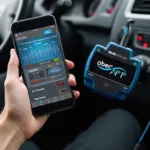Swapping an OBD2 motor into an OBD1 chassis is a popular modification, offering the potential for increased performance, improved fuel efficiency, and access to newer engine technology. This guide explores the intricacies of this conversion, covering everything from the technical challenges to the legal implications.
Understanding the Differences: OBD1 vs. OBD2
Before diving into the conversion process, it’s crucial to understand the key distinctions between OBD1 and OBD2 systems. OBD1, or On-Board Diagnostics 1, is a relatively simple system primarily focused on emissions control. OBD2, introduced in 1996, is a more sophisticated system that monitors a wider range of engine parameters, enabling more precise diagnostics and improved emission control. The core difference lies in the complexity and the amount of data each system handles. This difference affects everything from the wiring harness to the diagnostic tools used. Integrating an OBD2 motor into an OBD1 chassis requires bridging this technological gap.
Challenges of Putting an OBD2 Motor in an OBD1 Chassis
Integrating an OBD2 engine into an older OBD1 chassis presents several key challenges. First and foremost is the wiring. OBD2 systems utilize a more complex wiring harness and different connectors. Successfully integrating the engine requires meticulous planning and potentially custom wiring solutions. Another critical aspect is the ECU (Engine Control Unit). The OBD2 ECU needs to communicate with the vehicle’s other systems, which can be complex given the differences in technology. Furthermore, emissions compliance is a crucial concern. Swapping to a newer engine doesn’t automatically guarantee compliance with older emissions regulations. Understanding these challenges is the first step towards a successful conversion.
Navigating the Wiring Harness Maze
The wiring harness is often the most daunting aspect of this conversion. Adapting the OBD2 engine harness to the OBD1 chassis can involve splicing wires, creating custom connectors, and potentially integrating standalone wiring harnesses. A thorough understanding of both systems is essential. Resources like wiring diagrams and online forums can be invaluable. Consider consulting with experienced mechanics who specialize in engine swaps. This can save you time and prevent costly mistakes.
ECU Compatibility and Programming
The ECU is the brain of the engine. Ensuring compatibility between the OBD2 ECU and the OBD1 chassis is critical. In some cases, you might need to use a standalone ECU specifically designed for engine swaps. Programming the ECU is equally important. This involves configuring the ECU to communicate correctly with the vehicle’s other systems and ensuring optimal engine performance.
Emissions Compliance and Legal Considerations
Depending on your location, swapping an OBD2 engine into an OBD1 chassis can have legal ramifications regarding emissions regulations. It’s crucial to research and understand the specific laws in your area. In some cases, you may need to have the vehicle inspected after the conversion to ensure it meets emissions standards. Failure to comply can result in fines and other penalties.
Is it Worth the Effort? OBD2 Motor in OBD1 Swap Benefits
Despite the challenges, converting to an OBD2 motor can offer several benefits. Modern OBD2 engines are often more powerful and fuel-efficient than their older counterparts. They also offer advanced diagnostic capabilities, making troubleshooting easier. The improved performance and potential for enhanced fuel economy can make the conversion worthwhile for some enthusiasts.
Conclusion: Successfully Integrating an OBD2 Motor in an OBD1 Chassis
Swapping an OBD2 motor into an OBD1 chassis is a complex undertaking. It requires a thorough understanding of both systems, meticulous planning, and a willingness to tackle wiring challenges. However, for those seeking improved performance, enhanced diagnostics, and the benefits of newer engine technology, the rewards can be significant. Careful consideration of the challenges and a commitment to thorough research will greatly increase your chances of a successful conversion. Remember to always check local regulations regarding emissions compliance.
FAQ
- What’s the biggest challenge in this conversion? The wiring harness adaptation is often the most complex part.
- Do I need a standalone ECU? It depends on the specific engine and chassis combination.
- Is it legal to swap an OBD2 engine into an OBD1 chassis? Check your local emissions regulations.
- What are the benefits of this conversion? Improved performance, fuel efficiency, and advanced diagnostics.
- Where can I find more information? Online forums, wiring diagrams, and experienced mechanics.
- What tools do I need for this conversion? Standard mechanic tools, wiring tools, and potentially diagnostic software.
- How much does this conversion typically cost? Costs vary greatly depending on the specific engine, chassis, and labor involved.
If you need further assistance, please contact us via WhatsApp: +1(641)206-8880, Email: [email protected] or visit our office at 789 Elm Street, San Francisco, CA 94102, USA. Our 24/7 customer support team is always ready to help. We also offer further reading on our website related to OBD2 scanners, engine diagnostics, and vehicle maintenance. Check out our blog for more helpful articles!


